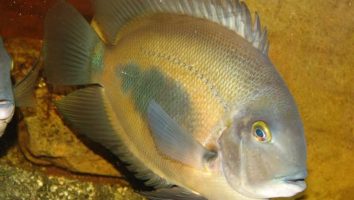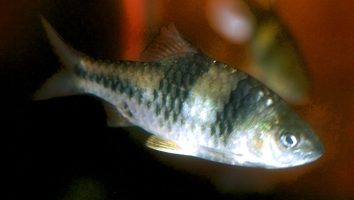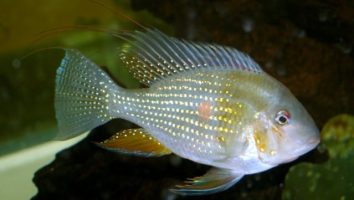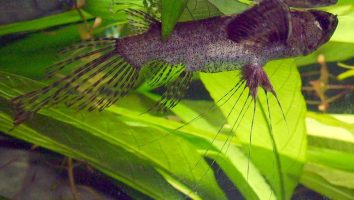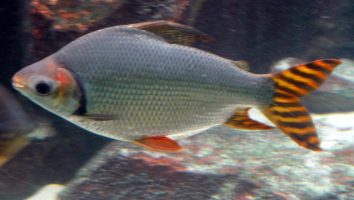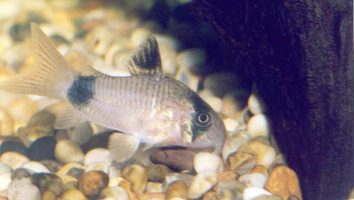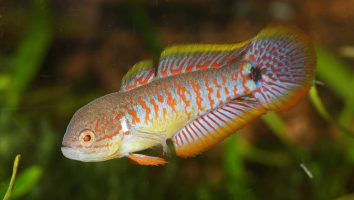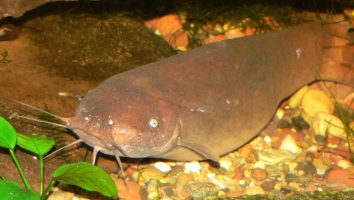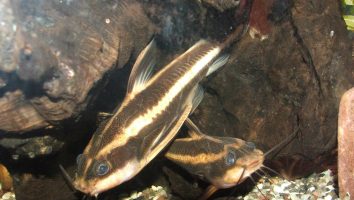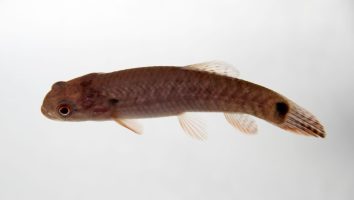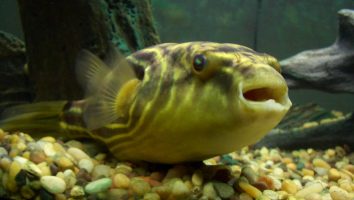The horseface loach is a freshwater fish that is native to Southeast Asia. They get their name from their long, horse-like snouts.
This fish is a popular choice for aquariums because of their unique appearance and peaceful nature. They’re also relatively easy to care for, which makes them a good choice for beginner fishkeepers.
In this guide, we’ll teach you everything you need to know about horseface loach care. You’ll learn about their diet, tank requirements, and more!
Table of contents
Species overview
The horseface loach (scientific name: Ajania ocellata) is a type of freshwater fish that’s native to East Asia. It’s found in various parts of China, Laos, Myanmar, Thailand, and Vietnam.
This fish prefers to live in slow-moving rivers and streams with a lot of vegetation. This is something common to many loach species, as they often use the plants to hide from predators.
The horseface loach is a relatively small fish, only reaching about 4 inches in length at most. They are brown or black in color with a white stripe running down the center of their body.
These fish are popular in the aquarium trade due to their peaceful nature and hardiness. They are compatible with a wide variety of tank mates and do well in most freshwater aquariums.
Appearance

The name of this fish is quite literal when you see it for the first time. The head of the Horseface loach looks a lot like that of a horse. They have a long “snout” that goes down the length of their face.
This is a bottom-dwelling fish that likes to hide in the substrate and among the plants. Because of this, they have a slim body that helps them to maneuver in and out of small spaces.
The majority of their body is a brownish color. They have a few dark stripes that run down the length of their body and get slightly darker towards their tail.
The dorsal, caudal, and anal fins are all a translucent brown. The ventral fins are white and begin about halfway down their slim bodies.
Horseface loaches have very small eyes that are placed towards the front of their head. This gives them excellent vision for finding food and avoiding predators.
Lifespan
The average lifespan of a Horseface loach is around 10 years. This is rather impressive and means that if you take good care of them, they’ll be around for quite a while!
Just like any fish, the lifespan of your Horseface loach can change significantly based on how they are treated. Things like poor water quality, stress from bad tank mates, or a suboptimal diet can drastically shorten their lifespan.
Size
The Horseface Loach grows to an average length of around 6 – 8 inches, with some specimens reaching up to 12 inches. They are a relatively slim fish, so won’t take up too much width in your aquarium.
Tank
Tank Size
The minimum tank size for a horseface loach is 20 gallons. If you want to keep more than one fish, you should add an extra 10 gallons for each fish.
Horseface loaches are a peaceful community fish but they do need a lot of hiding places. Be sure to add plenty of rocks, driftwood, and plants to your tank to give them plenty of places to hide.
Water Parameters
The horseface loach is a freshwater fish that is native to Southeast Asia. It is a relatively peaceful fish that does well in a community tank.
The horseface loach prefers to live in water that has a temperature of 68-77 degrees Fahrenheit, a pH of 6.5-7.5, and a water hardness of 5-19 dGH.
It is important to maintain a consistent water temperature and not allow the temperature to fluctuate too much. The horseface loach is also sensitive to changes in water quality, so it is important to do regular water changes and to keep the nitrate levels low.
What To Put In Their Tank
When it comes to setting up an aquarium for a Horseface Loach there are a few key things that you need to take into consideration.
First and foremost, these fish come from fast-moving rivers. This means that they’re used to a pretty strong water flow. You’ll need to provide them with an aquarium that has a good filter and pump system to recreate this.
The second thing to consider is that they come from habitats with a lot of hiding places. This is to protect them from predators, but it also helps to reduce stress levels.
You can provide them with hiding places by adding things like caves, driftwood, or plants to their tank. Just make sure that there are plenty of places for them to hide!
Finally, you need to consider the substrate. These fish come from habitats with sandy bottoms, so we recommend using a similar substrate in their tank.
Common Diseases
The horseface loach is a pretty hardy fish, but that doesn’t mean they can’t get sick. In fact, there are a few diseases that seem to target this species specifically.
The most common one is fungal infections. These can occur for a variety of reasons, but the most common one is simply poor water quality.
Fungal infections will present themselves as white patches on the skin of your fish. If left untreated, they will eventually spread to the gills and fins.
The other disease that horseface loaches are susceptible to is bloat. This is a condition that can affect any fish, but it seems to target horseface loaches more often than not.
Bloat is caused by a buildup of toxins in the fish’s body. This can be the result of poor water quality, overfeeding, or even stress.
The most obvious symptom of bloat is a distended belly. This is usually accompanied by a loss of appetite, lethargy, and difficulty swimming.
If you notice any of these symptoms in your fish, it’s important to act fast. Bloat is a serious condition that can quickly lead to death if it’s not treated.
The best way to prevent these diseases is to simply take good care of your fish. Maintain a high quality of water in their tank and don’t overfeed them. If you do these things, your horseface loaches should be healthy and happy for many years to come.
Behavior & Temperament
The horseface loach is a peaceful fish that does well in a community tank. It is nocturnal, so it will be the most active at night. During the day, it will find a hiding spot and remain there until nightfall.
This fish is a great addition to a tank because it helps keep the bottom clean by eating leftover food and algae. The horseface loach is also known to eat small invertebrates, so it may not be the best tankmate for shrimp or other small creatures.
Tank Mates
The horseface loach is a peaceful community fish that does well with a wide variety of tank mates. These fish are relatively small, so they can’t do much damage to other fish even if they wanted to.
This species is also shy and reclusive. They like to stick to themselves and are often seen hiding in the nooks and crannies of the aquarium.
As a result, you don’t need to worry about them being bullied by other fish. In fact, they’re often the ones getting picked on!
To create a balanced tank, choose tank mates that occupy different sections of the water column. Some good horseface loach tank mates include:
- Rasboras
- Tetras
- Guppies
- Danios
- Corydoras Catfish
- Plecos
- Loaches
Breeding
The horseface loach is a fairly easy fish to breed in captivity. They are egg-layers and will produce a large number of eggs at one time.
To breed horseface loaches, start by setting up a breeding tank. It should be at least 30 gallons and have a sandy bottom. Keep the water quality high and the temperature between 72 and 78 degrees Fahrenheit.
Then, add some plants and other hiding places. The plants are important because the female will lay her eggs on them.
When ready, add two females for every male. The males have more pronounced dorsal fins and are usually a bit larger than the females.
Feed the fish plenty of high-quality foods. Then, begin changing about 50 percent of the water. That should trigger spawning.
You’ll know you’re successful when you see the female lay her eggs on the plants. After she does that, the male will guard them diligently.
In about ten days, the eggs will hatch. You can move the babies into a nursery tank to improve their odds of survival. Feed them mashed peas and other green vegetables until they’re ready to join the adults in your main tank.
Conclusion
The Horseface Loach is an excellent addition to any aquarium. They are peaceful, hardy fish that will get along well with most other fish. They are also relatively easy to care for, which makes them a great choice for beginner aquarists.
If you are looking for a fish that is a little bit different and will add some character to your tank, the Horseface Loach is a great option.

